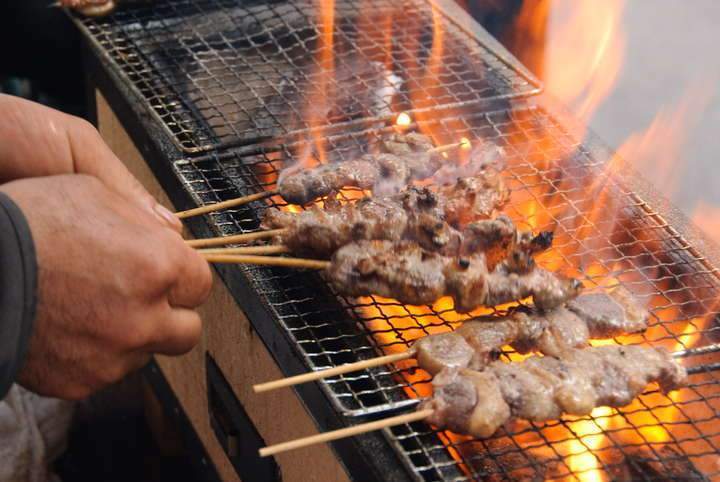Yakitori is a traditional of Japanese cuisine. Varies parts of chicken are cut into bite sized pieces, put onto skewers and cooked on a special charcoal grill (Gas cooked Yakitori is considered inferior and indeed tastes not as good). It is a very common type of Japanese street food and you can always get them in Izakaya and special Yakitori restaurant. Both my wife and I love Yakitori not only you can find them even at the most obscure corner; surprisingly affordable and most importantly, it is super tasty! I’d say Ramen and Yakitori is my comfort food while in Japan.

(One can easily find a Yakitori place in Japan like this one, photoshelter.com)
One would think that cooking Yakitori is quite easy and may try to do that at home. However the result is often we are hoping for in a bad way. The key lies in the special grill (diatom mud) and the white charcoal (Binchotan).

(Japanese Yakitori, glebekitchen.com)
The Okonoto Konro Grill
The most authentic Yakitori grill is quite portable and uses a special type of insulation material called Diatom mud from the Noto Peninsula of Ishikawa prefecture, Japan. The diatom mud is an excellent insulator that is able to keep the heat within the grill, therefore maintaining an high temperature: an essential ingredient for a tasty barbe! More importantly, since the temperature can reach up to 1200 degrees Celsius, the natural diatom mud, excavated from the seabed of Toyama bay. The natural means no harmful substance can leak out from the walls of the grill, unlike the ones made of materials from unknown region which can process harmful inclusions. The 5cm thick wall means the outer surface stays cool compared the steel grills.

The steady, high heat release from the Diatom mud material, allows the chicken to be cooked to perfection.
Binchotan
Aside from the Konro Grill, another vital component for the perfect Yakitori is the special charcoal called Binchotan.

(Chicken thighs grilling over binchotan charcoals Credit: Steve Dolinsky, pri.org)
Binchotan (備長炭), also known as Japanese white charcoal, is considered the most premium charcoal used for traditional cooking. It is produced using Japanese Ubame oak trees in a special Bincho Klin at around 1000 degrees Celsius, for up to 14 days. A very time-consuming process.

(Fresh out of the kiln, the Bichotan is still burning hot. BBC Travel)
The resulting charcoal is almost 100% carbon, Binchotan therefore producing very little smoke when burning, and leaving little ash and have a special metallic sound when tapping together. It is able to produce a very high heat (about 1200 degrees) and maintain a steady heat release for serval hours. Pure (without odour), high heat and long-lasting heat release really brings out the favour of the food, as a result, Binchotan is loved by top Japanese Yakitori restaurants.

(Premium Kishu Binchotan)
The total production of Binchotan in Japan is about 1800 tons per year (and only 3% is from the most prestigious region of Kishu). Consumers should pay attention to those non-authentic “Binchotan” produced outside of Japan with timber other than Ubame Oak using non-traditional techniques. Such charcoal cannot produce enough heat and burns out very quickly.
Bottom line
Just like your sharp knives for preparation, an authentic Japanese Knoro Grill and the matching Binchotan are the must-have gear for a perfect Yakitori cooked at home.
You can purchase our BBQ offerings from here.
Further Infomration:
Yakitorki Recipe, BBC Travel about Binchotan, Wikipedia (Binchotan), Washington Post about Binchotan:

